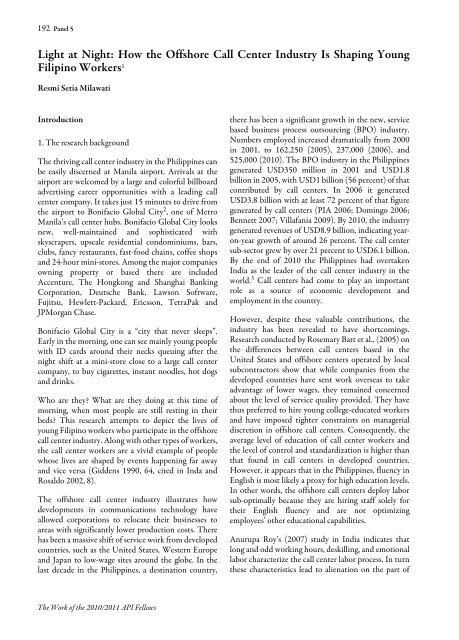Untitled - Api-fellowships.org
Untitled - Api-fellowships.org
Untitled - Api-fellowships.org
You also want an ePaper? Increase the reach of your titles
YUMPU automatically turns print PDFs into web optimized ePapers that Google loves.
192 Panel 5Light at Night: How the Offshore Call Center Industry Is Shaping YoungFilipino Workers 1Resmi Setia MilawatiIntroduction1. The research backgroundThe thriving call center industry in the Philippines canbe easily discerned at Manila airport. Arrivals at theairport are welcomed by a large and colorful billboardadvertising career opportunities with a leading callcenter company. It takes just 15 minutes to drive fromthe airport to Bonifacio Global City 2 , one of MetroManila’s call center hubs. Bonifacio Global City looksnew, well-maintained and sophisticated withskyscrapers, upscale residential condominiums, bars,clubs, fancy restaurants, fast-food chains, coffee shopsand 24-hour mini-stores. Among the major companiesowning property or based there are includedAccenture, The Hongkong and Shanghai BankingCorporation, Deutsche Bank, Lawson Software,Fujitsu, Hewlett-Packard, Ericsson, TetraPak andJPM<strong>org</strong>an Chase.Bonifacio Global City is a “city that never sleeps”.Early in the morning, one can see mainly young peoplewith ID cards around their necks queuing after thenight shift at a mini-store close to a large call centercompany, to buy cigarettes, instant noodles, hot dogsand drinks.Who are they? What are they doing at this time ofmorning, when most people are still resting in theirbeds? This research attempts to depict the lives ofyoung Filipino workers who participate in the offshorecall center industry. Along with other types of workers,the call center workers are a vivid example of peoplewhose lives are shaped by events happening far awayand vice versa (Giddens 1990, 64, cited in Inda andRosaldo 2002, 8).The offshore call center industry illustrates howdevelopments in communications technology haveallowed corporations to relocate their businesses toareas with significantly lower production costs. Therehas been a massive shift of service work from developedcountries, such as the United States, Western Europeand Japan to low-wage sites around the globe. In thelast decade in the Philippines, a destination country,there has been a significant growth in the new, servicebased business process outsourcing (BPO) industry.Numbers employed increased dramatically from 2000in 2001, to 162,250 (2005), 237,000 (2006), and525,000 (2010). The BPO industry in the Philippinesgenerated USD350 million in 2001 and USD1.8billion in 2005, with USD1 billion (56 percent) of thatcontributed by call centers. In 2006 it generatedUSD3.8 billion with at least 72 percent of that figuregenerated by call centers (PIA 2006; Domingo 2006;Bennett 2007; Villafania 2009). By 2010, the industrygenerated revenues of USD8.9 billion, indicating yearon-yeargrowth of around 26 percent. The call centersub-sector grew by over 21 percent to USD6.1 billion.By the end of 2010 the Philippines had overtakenIndia as the leader of the call center industry in theworld. 3 Call centers had come to play an importantrole as a source of economic development andemployment in the country.However, despite these valuable contributions, theindustry has been revealed to have shortcomings.Research conducted by Rosemary Batt et al., (2005) onthe differences between call centers based in theUnited States and offshore centers operated by localsubcontractors show that while companies from thedeveloped countries have sent work overseas to takeadvantage of lower wages, they remained concernedabout the level of service quality provided. They havethus preferred to hire young college-educated workersand have imposed tighter constraints on managerialdiscretion in offshore call centers. Consequently, theaverage level of education of call center workers andthe level of control and standardization is higher thanthat found in call centers in developed countries.However, it appears that in the Philippines, fluency inEnglish is most likely a proxy for high education levels.In other words, the offshore call centers deploy laborsub-optimally because they are hiring staff solely fortheir English fluency and are not optimizingemployees’ other educational capabilities.Anurupa Roy’s (2007) study in India indicates thatlong and odd working hours, deskilling, and emotionallabor characterize the call center labor process. In turnthese characteristics lead to alienation on the part ofThe Work of the 2010/2011 API Fellows
















